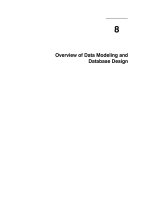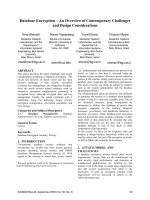Sets of Desirable Gambles and Credal Sets
Bạn đang xem bản rút gọn của tài liệu. Xem và tải ngay bản đầy đủ của tài liệu tại đây (186.8 KB, 11 trang )
Sets of Desirable Gambles and Credal Sets
Inés Couso (Univ. Oviedo), Serafín Moral (Univ. Granada),
SPAIN
ISIPTA 09 - Durham, U.K.
Gambles
◮
We have an uncertain taking values on a finite set Ω
◮
A gamble is a mapping X : Ω → IR
◮
X (ω) is the reward if X = ω
◮
Some gambles are clearly desirable for us (for example if
X (ω) > 0, ∀ω) and other are undesirable (for example if
X (ω) < 0, ∀ω)
Example
◮
Consider the result of football match with
Ω = {0 − 0, 1 − 0, 0 − 1, 1 − 1, 2 − 0, ......, 15 − 15}
◮
A gamble X1 (1 − 0) = 10, X1 (r ) = −1, otherwise
◮
Another example could be X2 (i − j) = 1, if i > j,
X2 (i − j) = −1, if i < j and 0 otherwise.
◮
If we believe in ’draw’ we could accept:
X3 (i − i) = 1, X3 (i − j) = −1, i = j
Almost Desirable Gambles
Desirable Gambles
Strictly Desirable Gambles
Coherent Set of Desirable Gambles
D1.
D2.
D3.
D4.
0 ∈ D,
if X ∈ L and X > 0 then X ∈ D,
if X ∈ D and c ∈ R+ then cX ∈ D,
if X ∈ D and Y ∈ D then X + Y ∈ D.
Basic Consistency Condition
A set of desirable gambles D avoids partial loss if and only if
0∈D
We should not accept: f (i − j) = −1 if i > j and 0 otherwise.
Closed Set of Gambles
A set of desirable gambles D is closed if D2, D3, and D4 are
verified.
Almost Desirable Gambles
D1’
D2
D3
D4
D5
∀X ∈ D ∗ , we have sup X ≥ 0
If X > 0, then X ∈ D ∗
If X ∈ D ∗ and λ > 0 then λ.X ∈ D ∗
If X1 , X2 ∈ D ∗ then X1 + X2 ∈ D ∗
If X + ǫ ∈ D ∗ , ∀ǫ > 0 then X ∈ D ∗
Basic Consistency Condition
A set of almost desirable gambles D ∗ avoids sure loss if and
only if ∀X ∈ D such that sup X ≥ 0
Desirable vs Almost Desirable Gambles
D1
Desirable Gambles
D3
D2
D4
D′
Almost Desirable Gambles
D5
D ′′
Desirable Gambles are a more general model
Desirable vs. almost desirable gambles
Let us consider the gambles:
Xǫ (i − j) = ǫ if i − j = 15 − 15,
Xǫ (15 − 15) = −1
◮
It is possible that all the gambles Xǫ are desirable.
◮
If they are almost desirable, then the gamble:
X0 (i − j) = 0 if i − j = 15 − 15, X0 (15 − 15) = −1
is almost desirable.
◮
Almost desirable gambles avoids uniform loss, but not
partial loss.
Strictly Desirable Gambles
D2 If X > 0, then D
D3 If X ∈ D and λ > 0 then λ.X ∈ D
D4 If X1 , X2 ∈ D then X1 + X2 ∈ D
D5’ If X ∈ D then either X > 0 or ∃ǫ > 0, X − ǫ ∈ D
Basic Consistency Condition: A set of desirable gambles D avoids
partial loss (0 ∈ D)
Upper and Lower Previsions and Desirable Gambles
◮
◮
The lower prevision of gamble X is
P(X ) = sup{α : X − α ∈ D}
The supremum of the buying prices.
The upper prevision of gamble X is
P(X ) = inf{α : − X + α ∈ D}
The infimum of the selling prices.
Credal Sets and Desirable Gambles
A set of desirable gambles D defines a credal set:
PD = {P : P[X ] ≥ 0, ∀X ∈ D}
◮ A set of desirable gambles D and the set of almost
desirable gambles D ∗ define the same credal set
◮ A credal set P defines a set of almost desirable gambles:
∗ = {X : P[X ] ≥ 0, ∀P ∈ P}
DP
◮ But several sets of desirable gambles can be associated:
DP = {X : P[X ] > 0, ∀P ∈ P} ∪ {X : X > 0}
D ′′ = {X : P[X ] ≥ 0, ∀P ∈ P, ∃P ∈ PP[X ] > 0} ∪ {X : X > 0}
◮
Graphical Representation: Credal Set
EP [X ] ≥ 0, ∀P ∈ P
Ω = {ω1 , ω2 , ω3 }
Non Desirable Gamble
Almost Desirable Gamble, Desirable?
Desirable Gamble and Strictly Desirable
Conditioning
If we have a set of desirable gambles D and we observe event
B, the conditional set of desirable gambles given B is given by:
DB = {X : X .IB ∈ D} ∪ {X : X > 0}
Example
I we accept a gamble
X (Win) = 1, X (Loss) = −1, X (Draw ) = 0,
if we know that Draw has not happened, then we should accept
any gamble:
Y (Win) = 1, Y (Loss) = −1, Y (Draw ) = α
In fact, all the conditional information is in D.
Conditioning
Ω = {Draw , Win, Loss}
B = {Win, Loss}
If P(B) > 0, then the credal set associated to the conditional
set D is uniquely determined with independence of what
happens with gambles in the frontier.
Conditioning: Lower Probability equal to 0
Ω = {Draw , Win, Loss}
B = {Win, Loss}
If P(B) = 0, all the gambles with X (D) = 0.0 are in the frontier.
The credal set does not contains information about the
conditioning.
Conditioning: Lower Probability equal to 0
X
X
Y
Z
Y +ǫZ +ǫ
B = {Win, Loss}
This situation is compatible with accepting as desirable the gambles:
X (D) = 1,
Y (D) = 0,
Z (D) = 0,
X (W ) = −1, X (L) = −1
Y (W ) = 1.2, Y (L) = −1
Z (W ) = −1, Z (L) = 1.2
But it is also compatible with gambles {X , Y + ǫ, Z + ǫ}
In this case, the conditioning is very wide: natural extension.
The case P(B) = 0
◮ Imagine that we have ω1 = ’There are less than 30 goals’; ω2 = ’Win or Draw
with 30 goals or more in total’; ω3 = ’Loss with 30 goals or more in total’.
◮ It is possible that we accept any gamble with
X (ω1 ) = ǫ, X (ω2 ) = −1, X (ω3 ) = −1
◮ If B = {ω2 , ω3 }, P(B) = P(B) = 0.
◮ The conditioning will depend of which gambles
g(ω1 ) = 0, g(ω2 ) = α1 , g(ω3 ) = α2
Regular Extension
◮ I have an urn with Red, Blue, White balls.
◮ I know that there is exactly the same number of Blue and White balls.
◮ This situation can be represented by the convex set of probability distributions:
P1
P2
Red
1
0
Blue
0
0.5
White
0
0.5
◮ If the set of desirable gambles is:
D ′ = {X : EP [X ] > 0, ∀P ∈ P}
then, if we know that a ball randomly selected from the urn is not red, then
conditional to this information, the gamble X (Blue) = 2, X (White) = −1 is not
accepted.
◮ This does not seem reasonable. I should accept any gamble in which
X (Blue) + X (White) > 0.
Regular Extension
Natural Extension
Regular Extension
Credal Set
D
Conditioning
DB
Credal Set
PD
Regular Conditioning
PDB
Theorem
Desirable gambles, regular extension is obtained assuming if
P(B) > 0 or:
X ∈ D ∗ and − X ∈ D ∗ ⇒ X ∈ D.
Natural Extension - Encoding sets of gambles
Natural Extension
If F is a set of gambles, its natural extension F is the set of
gambles obtained from F applying axioms A2, A3, and A4 (the
minimum set of gambles containing F and verifying these
axioms.
Finitely Generated Sets of Gambles
A set of almost desirable gambles D is finitely generated if
D = D 0 where D0 is finite.
This definition is not appropriate for desirable gambles. We
could not represent P(B) = 0. Which is equivalent to the
acceptance of gambles ǫ.IBc − IB for any ǫ.
Basic Reasoning Tasks
1. to determine whether the natural extension F is coherent
(i.e. 0 ∈ F ),
2. given X , to determine whether X ∈ F,
3. given X and B ⊂ Ω, to compute P(X |B) and P(X |B) under
F when this set is coherent.
Theorem
If F is an arbitrary set of gambles such that F is coherent, then
X ∈ F if and only if F ∪ {−X } is not coherent.
ǫ-set representation
A basic set of gambles is a set of gambles
FX ,B = {X + ǫB : ǫ > 0}, where X is an arbitrary gamble and
B ⊆ Ω, denoted as (X , B).
ǫ-set representation: F the union of: (X1 , B1 ), . . . , (Xk , Bk )
Representation of Conditional Probabilities
P(X |B) = c is represented by means of ((X − c)B, B)
P(X |B) = c is represented by means of ((c − X )B, B)
Checking Consistency
F generated by (X1 , B1 ), . . . , (Xk , Bk ): system in λi and ǫ has no solution:
Pk
λi (Xi + ǫBi ) ≤ 0
λi ≥ 0, ǫ > 0
i=1
Algorithms in P. Walley, R. Pelessoni, P. Vicig (2004).
1. Set I = {1, . . . , k }
2. Solve
P
sup P
i τi
s.t.
i (λi Xi + τi .Bi ) ≤ 0
λi ≥ 0, 0 ≤ τi ≤ 1
′
3. Let I = {i | τi = 1} > in the optimal solution
4. If I ′ = ∅, then Return(Consistency)
4. If I ′ = I = ∅ then Return(Nonconsistency)
5. else I = I ′ and goto 2
To compute P(X |B)
sup α
s.t.
Pk
λi (Xi + ǫBi ) ≤ (X − α)B
ǫ > 0, λi ≥ 0
i=1
Maximal Sets of Gambles
Definition
We will say that a set of gambles D is maximal if it is coherent
and there does not exist any X ∈ D such that D ∪ {X } is
coherent.
Lemma
If D is coherent and −X ∈ D,
coherent.
X = 0, then D ∪ {X } is
Theorem
A coherent set of gambles D is maximal if and only if X ∈ D xor
−X ∈ D, for all X ∈ L, X = 0.
Lemma
Let D be a maximal set of gambles and let P and P be
respectively the lower and the upper previsions associated to it.
Then P(B) = P(B), ∀ B ⊆ Ω.
Definition
If we have a sequence of nested sets
Ω = C0 ⊃ C1 ⊃ · · · ⊃ Cn = ∅, and B ⊆ Ω, then the layer of B
with respect to this sequence, will be the minimum value of i
such that B ∩ (Ci \ Ci+1 ) = ∅. It will be denoted by layer(B).
Theorem
If D is maximal then there is a sequence of nested sets
Ω = C0 ⊃ C1 ⊃ · · · ⊃ Cn = ∅ and a sequence of probability
measures P0 , . . . , Pn−1 satisfying the following conditions:
1. for each probability Pi , Pi (Ci \ Ci+1 ) = 1, Pi (ω) > 0 for any
ω ∈ Ci \ Ci+1 ,
2. for each A ⊆ B ⊆ Ω, if i = layer(B), then
P(A|B) = P(A|B) = Pi (A|B), where P(A|B) and P(A|B)
are the lower and upper probabilities computed from DB .
Coletti and Scozzafava (2002)
Maximal Gambles
Theorem
There exists at least one maximal set of gambles containing a
coherent set.
Theorem
If D is coherent, then D = ∩i∈I Di , where Di are maximal
coherent gambles containing D.
Correspondence (Sequences of probabilities <—>
Maximal coherent sets) non one-to-one
Ω = {ω1 , ω2 } and P0 (ω1 ) = P0 (ω2 ) = 0.5.
Any gamble with X (ω1 ) + X (ω2 ) > 0 is desirable.
Given Y (ω1 ) = 1, Y (ω2 ) = −1.
We can have Y desirable xor −Y desirable.
Alternative model one-to-one:
D1”. If X ∈ D, then there is ǫ > 0, such that
−X + ǫ supp(X ) ∈ D.
More Work
◮
More general representation schemes?
◮
Algorithms for them?
◮
Local computation
◮
Independence and local computation









